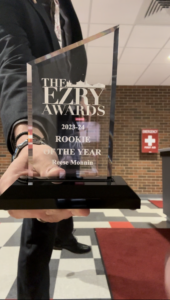A brief sweep of Wittenberg’s campus will greet any visitor with an abundance of hills and stairs. Though walking to class can be a tough climb for all students, it could present a real challenge to those with physical disabilities.
The 1990 Americans with Disabilities Act (ADA) was implemented to ensure that people with physical disabilities are not discriminated against and provided adequate facilities and accommodations. Admittedly, there are several buildings around campus that would pose a challenge to a physically disabled individual. Stairs must be climbed to enter Carnegie and Zimmerman buildings and the five-story tall Myers Hall is not equipped with an elevator. However, Wittenberg does everything to ensure that all students are accommodated, Michael Brady, Assistant Vice President of Physical Plant, assures.
“Wittenberg would do everything they could to accommodate the students’ wishes,” said Brady. “It’s not only being responsible to the student with the disability, it’s being responsible to students who are here already.”
Brady points out that many of the challenges facing ADA architecture on Wittenberg’s campus are out of the university’s control. To completely update the campus so that every building and facility was compliant with ADA standards, Wittenberg would have to significantly raise tuition. In addition the naturally hilly landscape of campus poses a design challenge.
“It’s just a hilly place – not the best for wheelchairs,” said Dave Wishart of the department of economics, who has been in a wheelchair since the age of 16. “Any time I’ve had a problem with accessibility, the problem has been rectified immediately after a quick and cordial phone call. Wittenberg has been a great place for me to work.”
While Wishart admits that the second and third floors of Recitation Hall would be difficult to reach and that a tram leading from Recitation to Hollenbeck Hall would make movement easier, he expresses generally positive views towards Wittenberg’s accessibility. When he was first hired at Wittenberg, Physical Plant worked with him to determine places to add curb cuts. Wishart also points out that the top campuses in the country for people with disabilities such as the University of Illinois, the University of Arizona, and Wright State University are relatively flat.
For sophomore Chelsea Horvath, the need for physically accessible features arose when she broke her foot a few weeks ago and was put on crutches.
“For the most part, I get around easily enough because people help me but some doors are heavy and the stairs to Krieg are hard,” said Horvath. “I moved from Myers to Firestine, which was nice but I had to move all my stuff myself.”
Brady also points out that it is important to maintain the architectural integrity of Wittenberg buildings on the outside. Many of the structures on campus are over 100-years-old and seen as a symbol of the university’s history. While there are currently no plans to renovate any facilities, Brady assures that any renovations that will occur in the future will be up to ADA standards.





